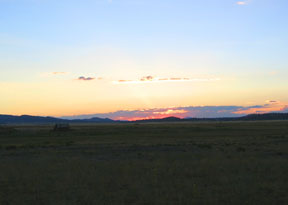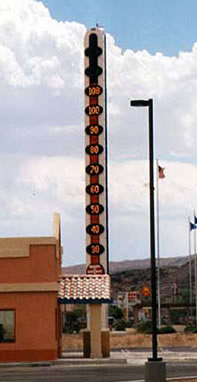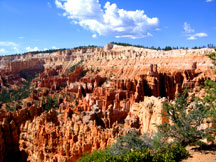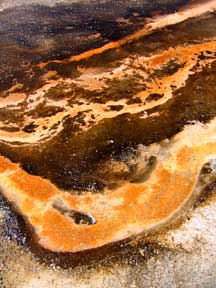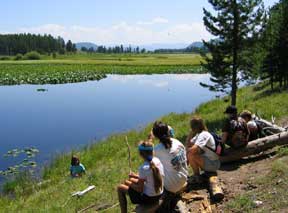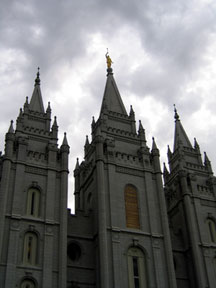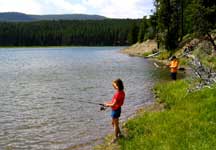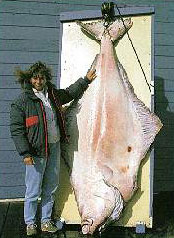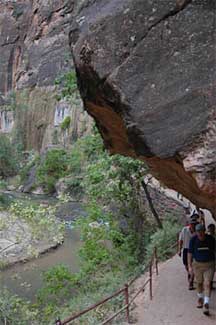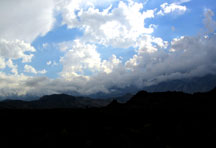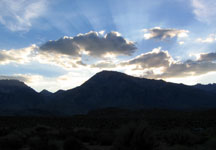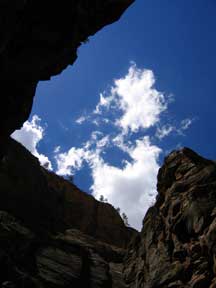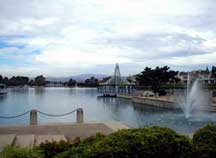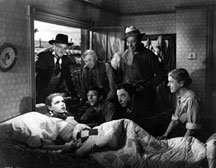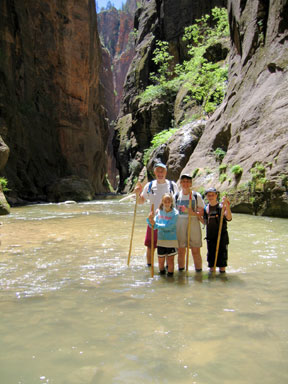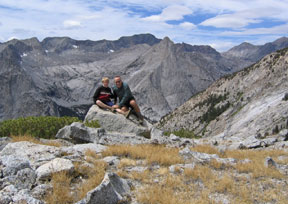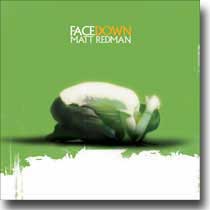| |
A Resource by Mark D. Roberts |
|
American Reflections
(0r What I Did in My Summer Vacation)
by Rev. Dr. Mark D. Roberts
Copyright © 2004 by Mark D. Roberts
Note: You may download this resource at no cost, for personal use or for use in a Christian ministry, as long as you are not publishing it for sale. All I ask is that you give credit where credit is due. For all other uses, please contact me at mark@markdroberts.com . Thank you.
The Vastness of America
Part 1 of series “American Reflections”
Posted at 10:00 p.m. on Friday, August 6, 2004
I have returned from vacation and am back to daily blogging. Not only did I need a break from what Hugh Hewitt calls “the harsh mistress” of a blog, but also, believe it or not, there are still many places in America where it’s hard to find decent Internet access. Don't camp in the Wyoming woods if you are addicted to the Internet!
As many of you may recall, after my last vacation I put up a few thoughts on what I had experienced, collecting them in a series called “European Reflections.” It seems only right to do likewise this time around. So I’m beginning a short series called “American Reflections.”
Yes, I am aware that I now have two pending series: “Church . . . What Really Matters?” and “Same-Sex Marriage.” I will return to these in time. But for now I want to share some thoughts (and pictures!) from my recent trek across California, Nevada, Utah, Idaho, Montana, and Wyoming. Among other things, this will help me get back into the mode of thoughtful blogging (I hope!).
I love driving vacations. I love to see the wideness and variedness of our country. But I haven’t attempted a driving vacation for many years because my children have been too young. As you can imagine, youngsters and long drives just don’t mix! Now, I’m glad to say, my children are old enough to spend extended hours in the car, and they're even able to enjoy the scenery along the way.
When I was a boy, my family took several driving vacations, including a circular tour around the entire U.S. These trips, plus my explorations as an adult, had taken me to 43 of the 50 United States. But until this summer, I had never visited Idaho and Montana, nor had I seen the fabulous national parks in Wyoming and Utah. My recent driving vacation remedied this deficiency in my American experience. Now I’ve visited 45 states. (I've got only 5 more to go before I fulfill my goal of visiting all of the states.)
| Unlike flying, driving allows you to appreciate the vastness of America. You spend hours looking at a slowly changing, ever expanding landscape. You see dozens of cities, hundreds of small towns, and thousands of farms, and millions of acres of open space. You see mountains in the distance, and drive sometimes for hours before you reach them. In the western U.S., you can drive for what seems like an eternity and only occasionally celebrate the crossing of a state line. Whatever else we’ve got in this country, we have space, and lots of it. |
|
| |
Sunset over a high plain outside of Bryce Canyon, Utah |
I mention this because we city dwellers can often feel crowded, squashed between buildings, freeways, and traffic jams, caught in the vice grip of urban sprawl. Yet for most of us, the wide open spaces aren’t that far away – if we make the effort to visit them. (I admit that things are a little cozier on the East Coast. But when I lived in the Boston area I was always amazed at how a hour’s bike ride would carry me off into some sparsely populated woods.)
Why does it matter for us to experience the vastness of America? Well, for one thing, it helps us to see our country as it is, to appreciate it’s openness and availability. We city dwellers, especially in major population centers, can often forget what the real America looks like. We can easily become claustrophobic and narrow-minded, pretending as if our over-crowded reality represents the whole country.
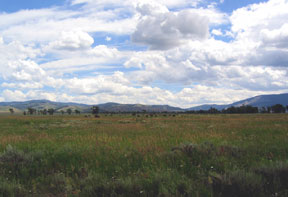 |
Moreover, wide open spaces both stretch and shrink us. They stretch our vision. They feed our imagination. Yet, at the same time, they also remind us how small we really are in the vastness of this land. They shrink our presumption, our self-importance, our pride. As I survey the intellectual and political landscape of our country, I think we could all use more vision, imagination, and the humility that comes from realizing that we’re not quite as big as we thought we were. I know I could.
Home |
Open spaces in and beyond Grand Tetons National Park in Wyoming. The tiny brown spots in the grass below the trees are actually a herd of Bison. |
|
Diverse, Inspiring Beauty
Part 2 of series “American Reflections”
Posted at 10:00 p.m. on Saturday, August 7, 2004
Although I haven’t traveled extensively beyond our national borders, I’m willing to bet that no country on earth can match the diverse beauty of the United States. During a recent vacation my family and I drove through parts of seven states: California, Nevada, Arizona (a tiny corner), Utah, Idaho, Montana (another tiny corner), and Wyoming. What we saw was not only stunningly beautiful, but incredibly diverse as well.
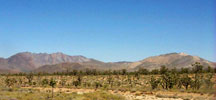 |
Early in our trip we passed through the Mojave Desert of California, an arid but intriguing region that stretches for hundreds of miles. No barren wasteland here, but a fascinating collection of hills, rocks, and plants that can withstand the intense, dry heat. During our drive the temperature reached 108º in the shade! I should know, because we passed through Baker, California, which claims to have the world’s largest thermometer. |
|
Mojave Desert with ubiquitous Joshua trees
|
|
|
Baker's thermometer |
| As we drove through Nevada and Arizona, gaining elevation, the desert morphed into increasingly striking rock formations – the sort of thing you see in classic “old west” movies. Though we saved the Grand Canyon for another trip, we did visit a dazzling national park in Utah: Bryce Canyon. Words and small photos can’t begin to capture the almost unearthly colors and shapes of this natural wonder. The combination of color and weather-shaped rock is truly unique, especially in the early morning or late evening, close to sunrise or sunset, when the colors are most vivid. |
|
| |
Rock formations in Bryce Canyon |
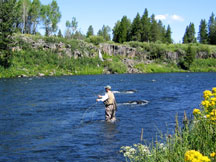 |
From Utah we headed north, spending a couple of days in the pine and fir forests of eastern Idaho. There we joined some friends. One of my friends, a fishing fanatic, tried his luck on Henry’s Fork of the Snake River. I’ve never been much of a fisherman, but I enjoyed watching him while sitting in the thick woods and sunny meadows by the river, spaces filled with wildflowers and surprisingly few mosquitoes. (After watching my friend and others "fish," I think the sport deserves a new name, "casting." Then when people ask, "How'd it go?", you can say, "Great! I did some wonderful casting today." You're no longer dependent on the persnickety fish for a successful outing.) |
| A friend fishing in the Snake River |
|
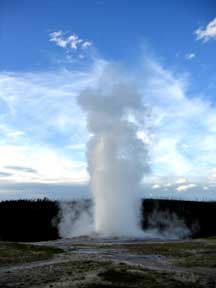 |
Driving east, we entered Yellowstone National Park, which, all by itself, features some of the most diversely beautiful scenery I have ever been blessed to enjoy. Yes, of course we stopped by Old Faithful, which was gracious enough to spout off within minutes after our arrival. Recent earthquakes have stretched Old Faithful’s interval between eruptions to slightly more than an hour. (Check out the live webcam if you want to see in miniature what we saw in person.) Yet Yellowstone’s most famous geyser is simply one of hundreds of similar features in this national park. Even the ground in Yellowstone can look unlike anything you’ve ever seen before. |
|
Old Faithful erupting
|
|
|
Ground in thermal area of Yellowstone, combination of minerals and bacteria that thrive in the hot ground. |
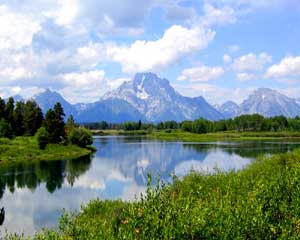 |
From Yellowstone we drove south to Grand Tetons National Park, where the combination of mountains, rivers, lakes, and forests is unmatched. We also enjoyed seeing unusual wildlife, including: moose, bison, bald eagles, osprey, and much more. The sunsets in this part of the country were awe-inspiring, owing their beauty to the unique combination of mountains and clouds. |
|
Mt. Moran in the morning
|
|
|
Sunset in the Tetons
|
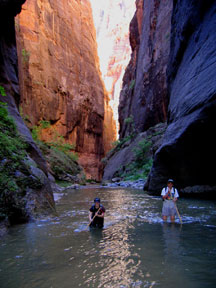 |
On our way back to California we stopped by Zion Canyon National Park in Utah for an all too short visit. Though not as large as the Grand Canyon, Zion features astounding configurations of colored rock formations and cliffs that take your breath away. Moreover, unlike when you visit the Grand Canyon, in Zion you start at the canyon floor, peering up at towering peaks and canyon walls. My family and I hiked up a narrow portion of Zion, something I’ll say more about in a future post. |
|
My wife and son hiking in "the narrows."
|
|
|
Panorama of Zion Canyon
|
Even though I’ve hardly touched upon all we saw during our brief journey, I think you can begin to get the picture. The diverse beauty of the United States, in only seven contiguous states, is unmatched. And I haven’t even considered the coast of Maine, the Everglades of Florida, the beaches of Hawaii, the fjords of Alaska, the autumn hills of Vermont, or the great plains of Kansas.
In this election year, it’s easy to lose sight of America’s goodness. Our hearts can be filled with the sleaze of electoral politics, forgetting even the immense privileges we have as free people living in a democracy. Truly the greatness of America has much to do with our system of government, not to mention the character and commitment of our people. But this country is also filled with diverse beauty, with sights that dazzle our eyes and widen our hearts. No matter where you live, you don’t have to travel far to marvel at the splendor of our land. So even if you can’t trek across seven states, I’d urge you to make time to visit some place of inspiring beauty. It will clear out your head and help you fall in love with America again.
Home
In Praise of Sitting
Part 3 of series “American Reflections”
Posted at 10:00 p.m. on Sunday, August 8, 2004
When is the last time you just sat? I’m not talking about sitting as a means to do something else, like sitting to work at a desk or eat a meal or watch TV. I’m speaking of sitting as an intentional posture, as something done not to accomplish some other task so much as a means of accomplishing very little. Can you ever truthfully echo the classic words of the once-popular 70’s poster: “Sometimes I sits and thinks. But sometimes I just sits”?
I’ll admit that I rarely “just sits.” Once in a great while I’ll plop down in my back yard with no agenda other than enjoying the warmth of a Sunday afternoon. But I tend to be such a task oriented person that even this can be a short lived joy. As I sit, I begin to see all the things I should be doing to improve my garden: weeding, planting, trimming, and so forth. My attempt to sit quietly often turns into a planning session for future gardening exploits. Not exactly the point of “just sitting.”
When I’m on vacation, however, I’m far enough away from the daily grind to sit for a while, to be quiet, to watch, to listen, and simply to be.
When I do this, I find all sorts of interesting things happening to me. For one thing, I can feel the stress of my busy life draining out of me. Sometimes this can even be a physical feeling, when I realize how tight my shoulders have been and when I feel them slowly loosening.
Sitting also heightens my sensitivity to what’s happening around me. All of a sudden I hear sounds I have been missing: the buzzing of insects, the chirping of birds, the quiet whisper of the wind in the trees. Moreover I see the world differently, with greater clarity and deeper appreciation. The sky looks bluer and better when I’m sitting quietly.
| Sometimes I sit alone. Sometimes I sit with others. Company is fine, just so long as my companions understand the unwritten rules of “just sitting”: little talk, no chatter, lots of shared silence. At one point in our recent vacation I found myself sitting on a log by Swan Lake in Grand Tetons National Park. Even though I was with a large group, including several young children, the stillness of the environment encouraged communal sitting. As we sat, we noticed animals that we otherwise wouldn’t have seen: a Great Blue Heron on the opposite shore, a pair of Sandhill Cranes, and a beaver swimming with its nose barely exposed above the water. |
|
| |
Swan Lake, Grand Tetons National Park
|
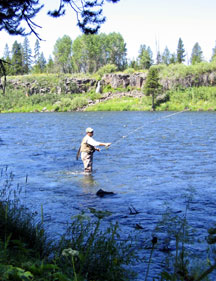 |
In my last post I mentioned watching my friend fish in the Snake River in Idaho. What I didn’t mention was that I watched him for about five hours, sitting comfortably in my portable beach chair. I had brought a book to read, but probably didn’t get through ten pages the whole time. I took a few pictures, including the one you see to the left. But mostly I just sat, sat and relaxed, sat and watched, sat and enjoyed. It was glorious.
For me, sitting is often a prelude to gratitude. When I sit I see. I see the beauty of creation. I see the intricacy of nature. I see the diversity and richness of colors. As I sat in the Idaho woods, I thanked God for the wonders of this world, and for the gift, not only of seeing, but of delighting in his creation. I suppose most animals could see the Snake River flowing through Box Canyon in eastern Idaho, but would they enjoy its loveliness? I doubt it. God has made us with a unique ability to delight in beauty. What a blessing! |
My view as I sat and watched an avid fisherman trying out Henry's Fork of the Snake River in Idaho |
|
It’s common these days for health gurus to warn us against a sedentary lifestyle. Indeed, even the U.S. Government has weighed in on its dangers. I surely concur, and struggle to make time for the exercise I need to remain healthy. But I’m also aware that my emotional health needs, not only regular exercise, but also regular sitting. Of course I’m not talking about beer and Cheetos in front the TV, but intentional sitting in a place of quiet and sublime beauty. I need this. And so do you.
Home
Wildlife
Part 4 of series “American Reflections”
Posted at 10:00 p.m. on Monday, August 9, 2004
One of the highlights of our recent vacation was seeing unusual wildlife. During our ten-day tour of national parks in Utah and Wyoming we saw many animals, including:
Moose in Grand Tetons National Park |
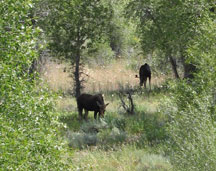 |
Elk on the Firehole River in
Yellowstone National Park |
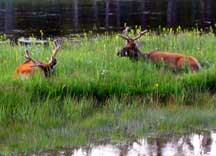 |
Bald Eagle along the Snake River in
Grand Tetons National Park |
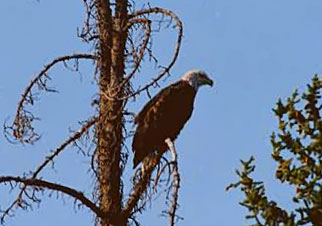 |
Bison in Hayden Valley of Yellowstone National Park |
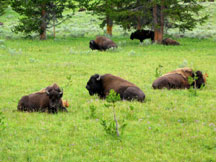 |
Pronghorn (American antelope) in Bryce Canyon National Park |
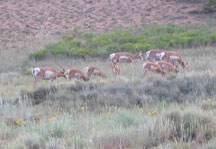 |
An osprey catching a trout in the Firehole River of Yellowstone National Park. One of the highlights our our vacation. |
 |
When I speak of “wildlife,” I mean this quite literally. The animals we saw were truly wild. They didn’t show up on cue for the tourists. And they weren’t in some sort of petting zoo. The national parks are very clear about keeping far away from the animals, requiring that we stay at least 25 yards away from all animals, except for bears, who require 100 yards of distance. (Sounds good to me. Somebody needs to tell the bears!)
We did see some fools walking very close to the moose and bison. One family was about five yards away from a small herd of very large bison. Apparently they have never seen a bison charge, which we did see. These enormous animals (some twice as big as an ordinary cow) run faster than 30 miles per hour, and when bothered, they are quite ornery.
If you’re as old as I am, you may remember a time with the national parks encouraged human interaction with animals. When I was a boy, I fed by hand the wild-but-not-too-wild deer at Yosemite. Bears were encouraged to find their meals in a local trash dump so the tourists could easily see them. But all of this has changed, partly owing to a desire among park officials to leave things in a natural state, and partly because teaching bears to eat human food turned out to be a very bad idea, both for people and ultimately for the bears. Once these powerful animals discovered that human food was tasty and easy to find, that’s all they wanted. Soon they attacked ice chests, cars, and even people in the search for a bear's version of fast food. Bears became so enamored with human food that they couldn’t be retrained to eat berries and grass (Do you blame them?). Eventually such bears had to be killed in order to protect national park visitors. Hence the omnipresent slogan throughout the parks today: “A fed bear is a dead bear.”
The national parks also make a big deal about securing all food in places bears can’t reach. Because bears have such an acute sense of smell, and because they’re so attracted to human food, you have to lock everything edible (and even toiletries) in steel containers or inside of hard-sided RV’s. Even then, however, bears can still smell food and may be tempted to get it. (Friends of mine tried to hide food under a car seat when visiting Yosemite, and had the door of their car bent in half and the seat destroyed by a hungry bear.)
Virtually every piece of national park literature in Yellowstone includes specific instructions about what to do if you encounter a bear. The main rule is to walk away slowly. Running away suggests to a bear that you may be prey (or be unwilling to share your snack, at any rate). Bad idea! But some of the official rules, however sensible from one perspective, seem rather hard to follow. If, for example, you are hiking in the forest with a back full of food, and if a bear approaches, you’re not supposed to abandon your pack with the food. One leaflet puts it this way:
Do not drop your pack if a bear is close by. Allowing a bear to obtain human food even once often results in the bear becoming aggressive about obtaining such food in the future. Aggressive bears present a threat to human safety and eventually may be destroyed or removed from the park.
Now I’m just fine with this in the abstract. But if you think about it much, you may decide not to follow this particular directive. Consider the following chain of reasoning:
1. A bear approaches as you are hiking out in the woods. It seems interested in you and your pack. You know that bears love human food and can smell it even from long distances.
2. You also know that some bears have tasted human food, and may think of a backpack as a treasure chest of a free, delicious lunch. The bear you face seems to have this in mind, as far as you can tell.
3. You reason that it's possible that the bear wants your food, not your flesh, as it approaches. But you realize that the bear won’t exactly ask nicely for your pack. Mauling is much more likely if the bear wants your lunch and you insist on keeping it in the pack on your back.
4. So you have a choice. Drop your pack in the hope that the bear will tear it up rather than you. Keep your pack on your back, realizing that the bear might keep on following you until it gets your food. As the park literature says, when bears have tasted human food, they become “aggressive about obtaining such food in the future.” So what would you do at this point? Follow the rules? Or save you skin -- perhaps literally?
| I’m completely in favor of letting wild animals be wild. And I want all bears to have long, happy lives. However, I must confess that if I were being stalked by a hungry, potentially-aggressive bear that seemed to want my pack, I just might be inclined to drop it. Let’s face it, though wild bears aren’t as friendly as Yogi, they may still be inclined to swipe your picnic basket. Honestly, I’d rather sacrifice my lunch than my arm or my life. |
|
Having made this confession, I nevertheless strongly support the efforts of national park officials to help wild animals and wild areas remain wild. Part of the mystery and delight of visiting these areas is seeing wildlife that is really wild.
Home
Friendly, Helpful Strangers
Part 5 of series “American Reflections”
Posted at 10:00 p.m. on Tuesday, August 10, 2004
Time and again throughout my recent vacation I was impressed with the friendliness and helpfulness of strangers. For most of my life I’ve been “city folk.” And, though some city dwellers fit into the friendly and helpful category, many do not.
Maybe it’s just my imagination, but it seemed to me that waiters, checkout people, and gas station attendants are friendlier in Utah and Wyoming than they are in Southern California. While we were staying in Grand Tetons National Park, for example, we had some mechanical trouble with our rented RV (a 24-foot Class-C motorhome, in case you’re wondering). We took it to the local service station, where a mechanic spent about a half-hour poking around in the engine area and under the dashboard, often straining in very awkward physical positions. In the end he diagnosed our problem, but said that he didn’t have the equipment to fix it. When I asked what I owed him, figuring that it would be around $40.00, maybe even more if he had an hour minimum, the helpful, friendly mechanic said: “Oh, nothing. Don’t worry about it. Just have a good trip!” When is that last time you heard something like this from a mechanic who has just spent a half-hour turning himself into a pretzel while trying to fix your car?
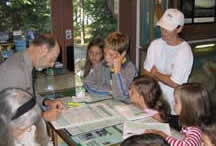 |
Even people whose official roles required them to be hospitable seemed to exude an extra dose of friendliness. In Yellowstone my daughter and a couple of friends joined a junior ranger program. They hiked, visited exhibits, read informational literature, and filled out an extensive test form. Then they took their results to a park ranger, who graded the test and asked other questions to make sure the children had really done their homework. Finally, he presented them with their junior ranger badges in a special ceremony, actually getting the attention of everyone in the visitor center so all could celebrate the achievements of my daughter and her friends. In my opinion, this ranger went far beyond the call of duty to make the children feel special. And he wasn’t some designated “children’s ranger,” but simply the person behind the desk who was available. |
 |
I confess: I’m not by nature a particularly friendly person. I’m basically shy, and sometimes my shyness can even seem to others like aloofness. Perhaps I’d be friendlier if I’d grown up in Utah or Wyoming. Who knows? But it’s a little late for me to relive my urban/suburban childhood. I did come away from vacation with a new commitment to reach out beyond my comfort level, however, to be a little more like that mechanic in the Tetons or that ranger in Yellowstone.
Home
American Religion
Part 6 of series “American Reflections”
Posted at 10:00 p.m. on Wednesday, August 11, 2004
Utah is the home, not only of astounding scenic beauty, but also of The Church of Jesus Christ of Latter-Day Saints, better known as The Mormons. Though begun in New York through the visionary efforts of Joseph Smith, Mormonism found a home in the area we know as Utah under the leadership of Smith’s successor, Brigham Young. On July 24, 1847, Mormons first entered the Valley of the Great Salt Lake, where they began settling in the place we know as Salt Lake City. Today, this city is the spiritual and physical center of Mormonism, the location of the primary Temple and Tabernacle (home of the famous choir).
Mormonism is an American religion in that it was created by Americans and is still led by Americans (though millions throughout the world, especially in Latin American, are now Mormons). Yale professor Harold Bloom, in his book The American Religion, sees Mormonism as classically American, not only because it was instigated by Americans, but because its ethos fits so well with American culture. |
|
| |
The Mormon Temple in Salt Lake City. |
Given the predominance of Mormonism in Utah, I was surprised to learn that only about 75% of the population in the state identifies with the LDS church. And I was also surprised to see a consistent non-Mormon Christian presence throughout Utah’s cities and towns. Small Baptist churches could be found throughout the state, and even a few Presbyterian ones too. Fancy that!
When you get out into middle America, away from the large urban areas, you realize just how Christian our country is, at least on the surface. I’m not talking here about deep, personal faith, but about general religious orientation. I realize that I’m contradicting the common viewpoint of the secular press and the scholarly world, both of which emphasize the extraordinary and expanding religious diversity of America. One of my own Harvard professors, Diana Eck, recently published a book with this intriguing title: A New Religious America: How a "Christian Country" Has Become the World's Most Religiously Diverse Nation. Eck shows, rightly, that America is now filled with a wide variety of world religions. But she understates the pervasive presence of Christianity.
I’m not basing this criticism simply on my tour of Utah and surrounding states, but on a book I read during this tour. One of the most eye-opening books I’ve read in a long time is The Next Christendom: The Coming of Global Christianity. The author, Philip Jenkins, is a professor at Penn State University and, as far as I can tell, has no particular religious bias. Yet his research has led him to conclusions that are quite unexpected. I’ll cite a couple here, with more to come in future blogging (another series). Jenkins writes:
The strength of American Christianity, present and future, contradicts much received wisdom. Americans like to think of their land as one of diversity, perhaps a diversity unparalleled anywhere on the globe, but in religious matters at least, such a view is strikingly far from the truth. America remains today substantially what it has always been, namely a Christian country (p. 103).
One of the reasons why American remains to strongly Christian sounds almost completely counter-intuitive. Here it is: immigration! Though we tend to think of immigrants as bringing other religions – and of course some do – many of those moving to America are Christian. Again, I quote Jenkins:
Any likely Muslim growth through immigration will be far exceeded by the continuing Christian influx from Africa, Asian, and, above all, Latin America. To adapt Professor Eck’s title, what we are rather seeing is How Mass Immigration Ensured that a Christian Country Has Become an Even More Christian Country. (p. 105)
If you have a hard time believing what I just quoted, you’ll have to read Jenkins’ book for yourself.
| The presence of Christianity in America was underscored for me in a most surprising place and in a most surprising way. As my family and I were exploring Grand Tetons National Park, we stumbled upon The Chapel of the Transfiguration, a rustic, log building in a phenomenal setting. As my family wandered off to visit Menor’s Ferry, I just had to check out this little chapel. I was pleased to discover that The Chapel of the Transfiguration is an active Episcopal church. Its name comes from the scene in the gospels where Jesus is “transfigured,” revealing his heavenly glory. Those who planted this church believed, rightly, I think, that God’s glory was so obvious in the Grand Tetons that it reminded them of the transfiguration of Jesus. |
|
| |
The Chapel of the Transfiguration in Grand Tetons National Park, Wyoming. |
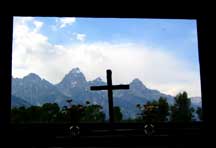 |
Allow me to end with a short theological comment. Part of what I loved about The Chapel of the Transfiguration was its humility. It was basically a small, very terrestrial log cabin with one heavenly picture window. The glory of God was present even though the building itself was not especially glorious – far from it, in fact. Thus this chapel is not unlike Jesus, who though he bore the very glory of God, nevertheless came in utter humility, and died in utter humility. The more we consider the glory of God in Jesus, the more we will marvel at the cross. And the more we focus on the cross, the more we will see the mind-boggling glory of God. |
The humble altar and cross in
The Chapel of the Transfiguration |
|
Home
Second Thoughts on Fishing
Part 7 of series “American Reflections”
Posted at 10:00 p.m. on Thursday, August 12, 2004
Earlier in this series I suggested that fishing should be renamed casting. This way, every attempt at casting (not fishing) would be successful. Nevermore would frustrated anglers add to their shame by having to tell others of their failures. Instead of "Did you catch any today?" the question would be "Did you cast any today?" The answer would always be an enthusiastic "Yes, indeed. The casting was great!"
Another idea occurred to me while helping my children do what people call fishing. A more accurate description, it seemed to me, would be to call the sport "untangling," since this is what I spent most of my time doing. |
|
| |
My two children "fishing" in Yellowstone, which enabled me to enjoy the sport of "untangling."
|
I haven’t yet received any nasty notes from serious fisherman, accusing me of dissing their beloved sport. Perhaps none of my blog readers are fisherman. Or perhaps my angling readers are out catching whoppers and don’t have time to write angry e-mails. Or perhaps everybody realized that my suggestion of changing the name of fishing actually reflected my own inability as an angler more than anything else. Anyone who guessed this would be right, actually.
My life as a fisherman began hopefully. When I was four years old, my family traveled to Oregon, staying along the Rogue River. I desperately wanted to fish and kept bugging my parents to let me try. Finally they agreed, and set me up with all I needed for successful angling: a stick, on which they tied a four-foot long string, on which they tied a small safety pin, on which they put some cheese. Bursting with confidence, I dropped my line into the river, sure that I was about to catch a big one. And then, wouldn’t you know it, I did snag a fish, dragging it up onto the dock. It wasn’t huge, but when you’re four, even an eight-inch long trout looks gigantic. Take that, fishing cynics!
But my life as an angler didn’t fulfill its early promise. Throughout my youth and young adulthood I went fishing probably fifty times. And I caught five fish, on the high side. In my thirties I did have a bit of luck in the High Sierra, snagging a few rare Golden Trout before letting them go. (I consider myself a “catch and release” fisherman, though “catch” is wishful thinking. I tend to be so respectful of the fish that I don’t even catch them in the first place.)
So, as I watched my friend and others try to catch fish in the prime, fish-filled waters of Idaho and Wyoming, but come up empty, you can see why I suggested changing the name of the sport to “casting.”
But now I must repent, utterly. An AP wire story changes everything.
Sally Balch and her husband went out last Sunday morning to fish in the waters near Ketchikan, Alaska. After a couple hours pulling in cod and halibut, they decided to call it a day (a good day, I might add!). But as Sally attempted to retrieve her line, it seemed to be snagged on the bottom. Finally, after an hour of effort, she and her husband pulled up a giant halibut. It was so large that the local fishing outfit wouldn’t even weigh it. Only a forklift from a local lumber yard was strong enough to move the fish, which was seven feet long, and estimated to weigh 323.8 pounds. Now that’s what I call fishing!
By the way, there’s no truth to the rumor that Ketchikan, a town on the coast of southern Alaska, was named to encourage fisherman: “Catch I Can.” The word actually comes from an Native American dialect, and means something about eagles’ wings. |
|
| |
This is not Sally Balch, but this unnamed woman caught this 300+ pound halibut near Ketchikan. |
For those of you inclined to go fishing (not just casting), Ketchikan is known as the salmon capital of the world. It boasts excellent fresh and salt water fishing. And for those of us who’d rather just sit on the dock and enjoy the view, here’s a live webcam from Ketchikan to whet your appetite. (Takes a minute to load, but go ahead and wait, and then dream!
Home
Not to Be Missed
Part 8 of series “American Reflections”
Posted at 10:00 p.m. on Sunday, August 15, 2004
| Earlier in this series I mentioned visiting Zion National Park in southwest Utah. The centerpiece of this park is Zion Canyon, the main portion of which is about fifteen miles long and one-half mile deep. This canyon is the product of weathering, primarily erosion by the Virgin River. Most of the time this river meanders gently through the canyon. But when it floods, it has awesome power to carve everything in its path, including the brilliantly-colored rock that forms the sides of Zion Canyon. |
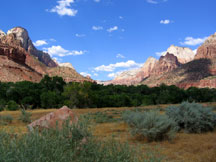 |
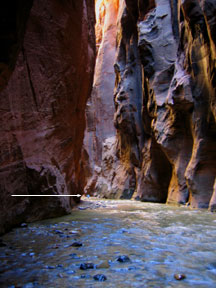 |
During our too-short stay at Zion, my family and I hiked up a portion of the Virgin River – literally. We often hiked right up the middle of the river. Why? you ask. Because we were in the “Narrows,” the upper portion of Zion Canyon, where the walls continue to tower 2000 feet above the canyon floor, but the canyon itself becomes very narrow. In fact, in the most striking section of the Narrows, called “Wall Street,” the canyon walls are only twenty feet apart.
Because of the peculiar geology of the aptly named Narrows, hiking up this portion of Zion Canyon often requires walking in the river. My family and I hiked more than four miles upstream, spending about half of our time in the river itself, and the other half walking on the sandy banks. Most of the time the water wasn’t very deep, coming up to my shins. Only a couple of times did it become waist high. On a few occasions we walked through small rapids, but there wasn't much danger. My children (ages 9 and 11) did fine. |
"Wall Street" in the narrows. To give you a sense of the scale, my daughter is the tiny blue dot in the center. |
|
| I call this adventure “a hike not to be missed.” I really mean this. If you ever have the chance to hike the Narrows, don’t miss it. It’s truly a once-in-a-lifetime experience (except that I plan to go again!). Among all the hikes I have done in life (and this is surely more than 300), I rank the Narrows right near the top in terms of beauty, fun, and adventure. Moreover, if you do it right, it isn’t terribly difficult. Besides, you can stop and turn around whenever you want to. But you won’t want to, I guarantee it. You'll wonder what's around the next corner. And when you see it, you won't be disappointed. |
|
| |
The light in the Narrows is truly magical. |
So here’s how to do the Narrows right:
 |
1. Get the right gear. There are a couple of business in the town of Springdale (just outside of the park) that rent special boots, booties made of wetsuit material, and poles. The cost is only $16.00 per person, and it’s money well spent. With this gear we were able to hike safely and comfortably in the river. (Thanks to Tod Bolsinger, author of It Takes a Church, for recommending both this hike and the appropriate equipment.)
2. Get a weather report. The outfitters in town have this information, as do the park rangers. You should not hike the Narrows if major thunderstorms are likely because these could precipitate a flash flood.
3. Leave fairly early in the morning. We hit the trail at 7:30 a.m., and I’m glad we did for two reasons. First, the trail (river) wasn’t crowded. By afternoon the lower part of the Narrows resembles Wall Street, not only because of the towering cliffs, but also because of the crowds. But we were blessedly alone for most of our hike. Second, the light in the morning is especially striking. |
My wife and son in one of the deeper portions of the river.
|
|
If you’re not a hiker, or if you’re not inclined to rent the gear, then you can still experience a bit of what I’m describing here by walking on the Riverside trail, which is the first mile of the Narrows hike. This is a paved trail, completely dry and almost completely flat. Nevertheless, even if you're not a big fan of hiking, a short trip up the river will pay rich dividends, and I highly recommend it.
Finally, if you ever hike the Narrows, please let me know. I’d love to hear your story.
Home |
|
| |
|
Enjoying the Sky
Part 9 of series “American Reflections”
Posted at 11:00 p.m. on Monday, August 16, 2004
I’m finishing my summer vacation with a beloved tradition, taking my son hiking in the High Sierra of California. This year, once again, we have made the town of Bishop our base camp. The town itself isn’t especially noteworthy, but it lies at the feet of some of the most beautiful mountains I have ever seen.
Yesterday, after concluding our hike, I sat for a long time on the grass outside of my motel, simply gazing at the sky. Clouds of all shapes, sizes, and qualities grasped my attention and fueled my delight. As I was sitting, a couple staying at the motel came out to join me on the grass. I watched to see if they would enjoy the sky as much as I was. But in fact they never really saw it. How sad, I thought. And then I started thinking about sky, and how wonderful it can be.
One of the things I have most enjoyed during my vacation is looking at the sky. Clouds, sunsets, lightning, and starry nights have blessed my eyes and filled my mind. As I watch the sky, I can feel both very small and very peaceful – at the same time. Somehow being a tiny part of creation doesn’t seem to be a problem, but more of a gift. |
|
Two pictures of the sky above Bishop. |
|
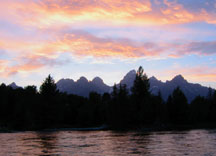 |
For some people, the sky is evidence to be evaluated. Farmers, weather reporters, and hikers look to the sky for a hint of rain. In the High Sierra, for example, a few small, billowy clouds in the early morning often portends a thunderstorm in the late afternoon. If you’re planning a long hike, this is valuable information. For me it says: “Bring a poncho.”
For others the sky is a source of inspiration, something to be felt rather than analyzed. The sky inspires art, hope, and, indeed, worship. As I sat watching the sky above Bishop, I thanked the Lord, not only for the beauty of his creation, but for making us with the ability to delight in it. |
Sunset above the Grand Tetons
|
|
Speaking of God, sky shows up throughout the Bible, beginning with the very first verse (“In the beginning God created the heavens . . . .”). In the Psalms the skies (or, as they are sometimes called, the heavens) figure prominently. Let me close with two marvelous passages from the Psalms:
The heavens are telling the glory of God;
and the firmament proclaims his handiwork.
Day to day pours forth speech,
and night to night declares knowledge.
There is no speech, nor are there words;
their voice is not heard;
yet their voice goes out through all the earth,
and their words to the end of the world.
Psalm 19:1-4
I will give thanks to you, O Lord, among the peoples;
I will sing praises to you among the nations.
For your steadfast love is as high as the heavens;
your faithfulness extends to the clouds.
Be exalted, O God, above the heavens.
Let your glory be over all the earth.
Psalm 57:9-11
|
|
| |
Sky from the bottom of Zion Canyon |
Home
There’s No Place Like Home
Part 10 of series “American Reflections”
Posted at 7:30 a.m. on Wednesday, August 18, 2004
There’s nothing quite like coming home after an extended time away. I remember returning from a family vacation when I was seven years old. We had spent two weeks camping at Lake Tahoe and Yosemite – the most time I had ever been away from home. Driving up the street where I lived, everything looked wonderfully familiar, and yet strangely different. It’s as if I were seeing my own home for the first time.
| I still have that kind of experience when I return from being away for a couple of weeks or more. Home feels wonderfully familiar, yet somehow different. I see the same things I usually see day in and day out, but against the background of far away places. Thus I see my own home more distinctly, at least for a few hours. I see things I mostly take for granted: the sun-drenched dryness of the local mountains, the lush green of the parks in Irvine, the hazy sunset of the evening sky, even the quiet calm of the local artifical lake. |
|
The experience of seeing home with fresh eyes is heightened if one has been far away, not only geographically, but also culturally. In my most recent vacation, the greatest cultural distance I experienced was in a restaurant in a small town in Utah, where I overheard an unusual conversation at the next table. A middle-aged man, speaking quite loudly, was complaining about how “the Negroes” were invading, and how the government was conspiring against us, and how we needed to be prepared to defend ourselves against the government, and so on. “I’m not in Kansas anymore,” I thought to myself, as I had visions of Ruby Ridge.
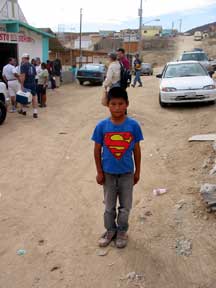 |
Of course a brief visit to “Smallville,” Utah hardly adds up to a life changing cross-cultural experience. It’s not like what happens, for example, when people from my church go on mission trips. This summer we sent a team to South Africa, and next week a large group will go down to a small barrio in Mexico, where they will build homes and enjoy the company of a host of children whose school tuition we help to pay. It will be an eye-opening time of service and celebration. When our mission trip folk return to Irvine, they will see everything here much differently. It's one of many benefits of such a trip, both for those who experience it directly, and for those who listen to their testimonies. |
When I come back from an extended time away, inevitably I feel grateful. I’m thankful to live in comfortable community. I’m thankful for the familiarity of my own bed. I like seeing people I know around town, people who will recognize me and greet me by name. For the next few days of heightened awareness I’ll actually pay attention to such things. Such attention, and, indeed, such gratitude are good. I can thank God for so many little things I usually take for granted. And I can agree with Dorothy Gale that, indeed, “There is no place like home.”
Of course, in a few days, the specialness of home will wear off a bit, and, I'm sad to say, so will my gratitude. I guess I'll just have to take another vacation next summer! |
|
| |
|
Home
Vacation: What Matters Most
Part 11 of series “American Reflections”
Posted at 9:30 p.m. on Friday, August 20, 2004
I’d like to conclude my series “American Reflections” with a consideration of what matters most to me about vacation.
To be sure, I enjoy (and need!) a break from the workaday world. Even though I feel grateful for the privilege of being a pastor and a writer, sometimes these callings are exhausting. When I’m at the end of my preaching year (usually in June or July), I can feel the tiredness of my spirit. In the classic phrase of Harold John Ockenga, former pastor of Park Street Church in Boston, I am “sucking the muck from the bottom of the well.” A break from the demands of pastoring and writing refreshes me and helps me get ready for the next stretch of ministry.
But what matters most to me about vacation isn’t taking an extended break from work.
I love to learn new things, and vacation gives me the chance to do this. If I’m traveling, I get to see new sights. I’m the sort of person who reads historical markers because I am fascinated by the history of places, what happened where and who did what. Plus, on vacation I get to read books I don’t have time to read in ordinary life – another opportunity for learning. As you know if you’ve been following this blog series, in the last month I was able to visit two states and three national parks that I’d never seen before (Idaho and Montana; Yellowstone, Grand Tetons, and Bryce Canyon). In all of these places my mind soaked up new information, much to my delight.
But what matters most to me about vacation isn’t learning new things. |
|
| |
I liked being able to see Old Faithful, and also learning about how geysers work. |
 |
If you’ve read my recent posts, you must have figured out how much I love nature. I love being in it, smelling it, listening to it, and, most of all, seeing it. I can spend hours just looking at mountains and rivers, clouds and flowers. One of the joys of my recent vacation was actually watching the deer and the antelope play (literally!). Being in nature rejuvenates me like little else in life. It restores peace to my soul and a sense of life’s rhythm. It reminds me of God’s power, creativity, and beauty. It helps me to worship with new vigor and passion.
But what matters most to me about vacation isn’t being in nature. |
How could the beauty of Mt. Moran in Grand Tetons National Park not inspire peace, even praise? |
|
So what matters most to me about vacation? Stay tuned. I’ll answer this question tomorrow.
Home
Vacation: What Matters Most (conclusion)
Part 12 of series “American Reflections”
Posted at 9:30 p.m. on Saturday, August 21, 2004
Yesterday I began to answer the question: What matters most to me about vacation? I consider three fine options: a break from work, learning new things, and being in nature. All of these are great. But none matters most to me.
So what matters most to me about vacation? To put it simply: spending time with my family, an extended stretch of time, both quantity and quality time. If you were to give me a choice: go on your recent vacation by yourself, or stay at home with your family, I’d choose family, no question about it. But going on a vacation offers the chance, not only to be with my loved ones, but to share new experiences with them, to get to know them in new ways. We get some rest together; we learn new things together; we enjoy nature together. And this sort of togetherness, for me, is priceless. |
|
| |
My family and I during our recent hike up the Narrows of Zion National Park. |
I didn’t always think this way. When Linda and I were first married, my dad gave us $3,000 to use for anything we wished. I knew exactly what I wanted to do with the money: buy a computer (my first, a Compaq portable weighing some 20 pounds and running only slightly faster than my abacus). Linda knew exactly what she wanted to do with the $3,000: go to Europe with me. I thought her priorities were crazy. What would we have after a trip to Europe, I reasoned, other than memories and a too many pictures? Nothing! But a computer would last for years. Nevertheless, Linda, with a little help from the Lord, persuaded me to spend three weeks in Europe with her in the spring of 1985. And it turned out to be some of the best weeks of my entire life. (We did get the computer soon after we returned from Europe, by the way. Now, seven computers later, my first Compaq is probably in some landfill somewhere, but I still cherish the memory of my trip with Linda.)
The lesson I learned in 1985 has stayed with me. If you were to examine our family budget, you’d find that we spend more money on vacations than many families (although we almost never splurge on expensive hotels or restaurants). Surely we spend less than other families on “stuff.” Our family stereo is more than fifteen years old and our ordinary definition television screen isn’t particularly large. We don’t even have cable or satellite TV! Rather, we have chosen to invest in vacation experiences that have enriched our family life.
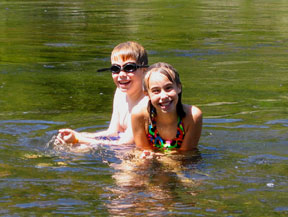 |
I’m grateful that we have enough money – through work and the generosity of friends – to do some fun and interesting things on our vacations, like visit Yellowstone National Park. But I also know that great experiences can be had cheaply, and often even for free. Linda and I have done our fair share of camping and sleeping in Motel 6s. Hiking, something we enjoy as a family, is basically free, once you have a minimal amount of equipment. So is bike riding, swimming, exploring, animal watching, going to the beach, and, yes, even fishing. (This is, without a doubt, one of the best things I can say about fishing. See my earlier grousing.) |
My children swimming in the Firehole River of Yellowstone. |
|
As a pastor, I get more vacation days than many of my friends. This is a gift, indeed. But just about anyone can get some time away if it is a priority. When I was growing up, my dad was caught in the aerospace bust of the early 70’s, so he had very little vacation time during several years. On more than one occasion he took a week of unpaid leave so our family could go camping. When he was between jobs he even risked taking our family on a six-week trip around the country. This is, without question, my all-time favorite memory from my childhood. I wouldn't trade this memory for all the money that my dad might have made if he had been working for those six weeks. |
|
| |
My son and I in the High Sierra of California, by La Conte Canyon, at the midpoint of our marathon 20-mile hike. What did we share together? Exhaustion, aching feet, wonderful conversations, lots of laughter, and invaluable memories. |
No matter how much vacation time you have, let me get up on my soapbox and urge you to spend a good chunk of it sharing experiences with your family. (If you’re single, you’ve got family too, and good friends as well.) I expect that, like me, you’ll discover that sharing experiences with those you love matters most of all.
Home
|

